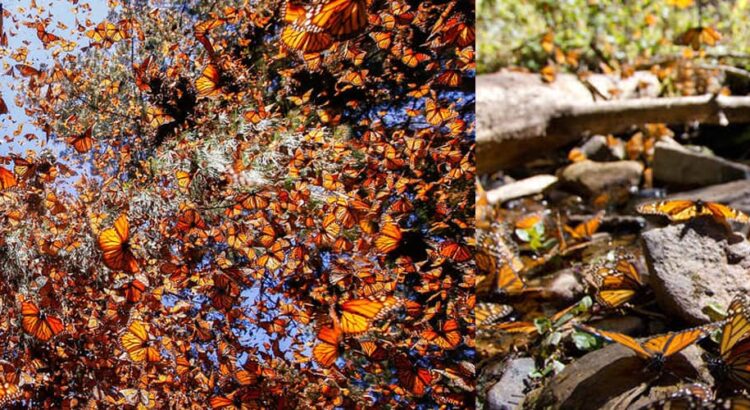The Monarch Butterfly, a captivating and iconic species, migrates thousands of kilometers to the mountains of central Mexico each year. These butterflies undertake a remarkable journey, arriving in vast numbers in the oyamel fir forests of Michoacán and the State of Mexico. The spectacle, known as the “Monarch Butterfly Biosphere Reserve,” draws nature enthusiasts and researchers alike. The monarchs’ vibrant orange and black wings blanket the trees, creating a breathtaking display and offering a unique ecological phenomenon. The reserve serves as a critical sanctuary for these butterflies during the winter months, contributing to their conservation and the understanding of their extraordinary migratory behavior.
How to get there
To visit the Monarch Butterfly Biosphere Reserve in Mexico, you typically need to travel to the overwintering sites in the states of Michoacán and the State of Mexico. Here are general guidelines on how to get there:
- Fly to Mexico City or Morelia:
- The Monarch Butterfly Biosphere Reserve can be accessed from major cities such as Mexico City and Morelia. Both cities have international airports.
- Mexico City International Airport (MEX) and General Francisco J. Mujica International Airport in Morelia (MLM) are common entry points.
- Travel to Angangueo or Valle de Bravo:
- The reserve has multiple entry points, and two common starting points are the towns of Angangueo in Michoacán and Valle de Bravo in the State of Mexico.
- From Mexico City or Morelia, you can take a bus, hire a taxi, or rent a car to reach these towns.
- Travel from Angangueo to the Reserve:
- From Angangueo, you can take guided tours or hire local guides to take you to the butterfly colonies within the reserve. The journey may involve a combination of walking and horseback riding, as vehicles may have limited access to certain areas.
- Travel from Valle de Bravo to the Reserve:
- If starting from Valle de Bravo, you can arrange guided tours or transportation to specific sites within the reserve. Valle de Bravo is closer to the State of Mexico’s portion of the reserve.
- Guided Tours:
- Consider joining guided tours offered by local operators. These tours often include transportation, guides, and sometimes meals. They provide valuable insights into the butterflies’ behavior and the ecological significance of the reserve.
- Respect Local Regulations:
- Check with local authorities and guides for any specific regulations or guidelines to follow during your visit. This may include restrictions on certain activities or designated paths to minimize environmental impact.
- Seasonal Considerations:
- Plan your visit during the monarch butterfly’s overwintering season, which typically occurs from late October to early March. The exact timing can vary each year.
Things to do
When visiting the Monarch Butterfly Biosphere Reserve in Mexico, there are several activities you can enjoy to make the most of your experience. Here are some things to do:
- Butterfly Watching:
- Witness the breathtaking sight of millions of monarch butterflies covering the trees. Guided tours are available to take you to the best viewing spots within the reserve.
- Guided Tours:
- Join guided tours led by local experts who can provide information about the butterflies’ behavior, migration patterns, and the ecological significance of the reserve.
- Hiking and Nature Walks:
- Explore the natural beauty of the reserve by taking hikes or nature walks. Many trails lead to butterfly colonies, and walking allows you to appreciate the surrounding flora and fauna.
- Horseback Riding:
- In some areas of the reserve, horseback riding is a popular way to navigate the terrain and reach butterfly colonies. Local guides often offer horseback tours.
- Photography:
- Capture the stunning visual spectacle of the butterflies with your camera or smartphone. The reserve’s unique scenery provides ample opportunities for nature photography.
- Educational Programs:
- Participate in educational programs offered by local conservation organizations. Learn about the monarch butterfly’s life cycle, migration, and the efforts to protect their habitat.
- Cultural Experiences:
- Explore the local towns of Angangueo, Valle de Bravo, or nearby communities. Experience the local culture, cuisine, and traditions.
- Visit Cerro Pelón Butterfly Sanctuary:
- Cerro Pelón is one of the sanctuaries within the biosphere reserve. Explore this sanctuary to see the monarch butterflies and enjoy the natural surroundings.
- Support Conservation Efforts:
- Contribute to conservation efforts by supporting local initiatives and projects aimed at protecting the monarch butterflies and their habitat.
- Stargazing:
- If you’re staying overnight, take advantage of the dark skies in the reserve for stargazing. The lack of light pollution provides an excellent opportunity for observing celestial bodies.
- Visit Piedra Herrada Sanctuary:
- Piedra Herrada is another sanctuary in the State of Mexico’s portion of the reserve. Visit this site to witness the monarch butterflies in a different part of their overwintering grounds.
Remember to plan your visit during the monarch butterfly’s overwintering season, typically from late October to early March. Check with local authorities for any regulations or guidelines, and consider hiring local guides to enhance your experience and learn more about the incredible journey of the monarch butterflies.
Things not to forget
When visiting the Monarch Butterfly Biosphere Reserve in Mexico, it’s essential to be well-prepared to ensure a comfortable and enjoyable experience. Here’s a checklist of things not to forget:
- Appropriate Clothing:
- Wear comfortable and layered clothing suitable for varying temperatures. Long sleeves, pants, a hat, and sturdy walking shoes are advisable.
- Sun Protection:
- Bring sunscreen with a high SPF, sunglasses, and a wide-brimmed hat to protect yourself from the strong sunlight.
- Insect Repellent:
- Use insect repellent to protect against mosquitoes and other biting insects.
- Camera and Binoculars:
- Bring a camera or smartphone to capture the incredible sight of the butterflies. Binoculars can enhance your wildlife viewing experience.
- Water and Snacks:
- Stay hydrated by bringing a reusable water bottle. Pack snacks to keep your energy levels up during hikes or walks.
- Backpack:
- Carry a small backpack to hold your essentials, such as water, snacks, sunscreen, and a camera.
- Cash:
- Bring sufficient cash, preferably in small denominations, for entrance fees, tips, and local purchases.
- Travel Documents:
- Carry identification, travel insurance details, and any necessary permits. Have a copy of your passport stored separately.
- Weather Protection:
- Be prepared for variable weather conditions. Pack a lightweight, waterproof jacket or poncho in case of rain.
- Medications and First Aid:
- Bring any necessary medications, a basic first aid kit, and personal hygiene items.
- Travel Adapters:
- If you’re traveling from a different region, bring a travel adapter to charge your electronic devices.
- Respectful Attire:
- Dress modestly, especially if you plan to visit cultural or religious sites. Respectful attire is appreciated in local communities.
- Local Currency:
- Carry some local currency (Mexican Pesos) for small purchases, tips, or donations.
- Guidebook or Map:
- Bring a guidebook or map of the area to navigate trails and understand the geography of the reserve.
- Respect for Nature:
- Follow responsible tourism practices. Stay on designated paths, avoid touching the butterflies, and adhere to any guidelines provided by local authorities.
- Cultural Sensitivity:
- Be culturally sensitive and respectful to local communities. Ask for permission before taking photographs of individuals.
- Contact Information:
- Carry contact information for your accommodations, local guides, and emergency contacts.
- Check Local Regulations:
- Before your visit, check for any specific regulations or updates regarding the reserve. Stay informed about any changes in entrance fees or visiting hours.
Best time to visit
The best time to visit the Monarch Butterfly Biosphere Reserve in Mexico is during the monarch butterfly’s overwintering season. The butterflies arrive in the reserve’s oyamel fir forests in large numbers, creating a spectacular and awe-inspiring sight. The primary overwintering period typically occurs from late October to early March. Here are some considerations for the best time to visit:
- Peak Season (Late November to February):
- The peak of the monarch butterfly overwintering season is generally from late November to February. During this time, millions of butterflies cover the trees, creating a breathtaking visual spectacle.
- Mild Temperatures:
- The winter months, especially December and January, offer milder temperatures compared to the warmer months. Daytime temperatures are usually comfortable for outdoor activities.
- Avoid Extreme Heat or Cold:
- The overwintering season is ideal because it avoids the extreme heat of the summer months and the colder temperatures of early spring. This ensures a more pleasant experience for visitors.
- Optimal Butterfly Activity:
- Visiting during the peak season ensures optimal butterfly activity. The butterflies cluster together on the trees, creating a dense and vibrant display.
- Guided Tours and Activities:
- Guided tours and educational activities are often available during the overwintering season, allowing visitors to learn more about the monarch butterflies and their conservation.
- Less Crowded:
- While the monarch butterfly biosphere reserve is a popular destination, visiting during the off-peak periods within the overwintering season may offer a less crowded experience.
- Photography Opportunities:
- Photographers may find the late fall and winter months to be the best time for capturing stunning images of the butterflies and the natural surroundings.
Is the monarch butterfly a symbol of Mexico?
Yes, the monarch butterfly (Danaus plexippus) is considered a symbol of Mexico and holds cultural significance in the country. The annual migration of the monarch butterflies to Mexico has become a natural wonder and a celebrated event.
The monarch butterflies travel thousands of kilometers from the United States and Canada to the oyamel fir forests in the states of Michoacán and the State of Mexico for their winter hibernation. The arrival of the butterflies is a symbol of the changing seasons and is often associated with the Day of the Dead (Día de los Muertos) festivities in Mexican culture, as it coincides with the time when Mexicans honor their deceased loved ones.
The Monarch Butterfly Biosphere Reserve in Mexico has been designated a UNESCO World Heritage site, recognizing its ecological importance and the cultural value placed on the annual migration. Efforts are made to protect the habitat and ensure the conservation of the monarch butterflies.
The symbolic significance of the monarch butterfly extends beyond its role in the natural world; it is embraced as a cultural and environmental emblem, representing beauty, transformation, and the interconnectedness of nature. The monarch butterfly’s image is often featured in Mexican art, literature, and celebrations, further solidifying its place as a symbol of Mexico’s rich biodiversity and cultural heritage.
When can you see monarch butterflies in Mexico?
The best time to see monarch butterflies in Mexico is during their annual overwintering season, which typically spans from late October to early March. However, the peak of the migration and the highest concentration of butterflies are often observed from late November to February. During this period, millions of monarch butterflies travel thousands of kilometers from the United States and Canada to reach the oyamel fir forests in the states of Michoacán and the State of Mexico.
Here’s a breakdown of key times during the monarch butterfly overwintering season:
- Early Arrival (Late October to Early November):
- The first monarch butterflies begin arriving in the Monarch Butterfly Biosphere Reserve in late October. While the numbers are not at their peak, this period can still offer a fascinating experience.
- Peak Migration (Late November to February):
- The peak of the monarch butterfly migration and overwintering season occurs from late November to February. During this time, the forests are filled with millions of butterflies, creating a breathtaking sight.
- Late Season (March):
- While the numbers may start to decline in March, you can still witness the butterflies in the reserve. March marks the end of the overwintering season, and the butterflies begin their journey back to the northern regions.
It’s important to note that the exact timing of the monarch butterflies’ arrival and departure can vary each year based on weather conditions, temperatures, and other factors. The butterflies are highly sensitive to temperature changes, and their migration patterns are influenced by environmental cues.
What do monarch butterflies do to get to Mexico?
The migration of monarch butterflies from the United States and Canada to Mexico is one of the most remarkable natural phenomena. The journey spans thousands of kilometers and involves several generations of butterflies. Here’s an overview of the stages and behaviors involved in the migration:
- Multigenerational Migration:
- Monarch butterflies are known for their multigenerational migration. The journey from the northern regions of North America to Mexico involves multiple generations of butterflies.
- Generation 1: Northward Migration:
- The first generation of monarch butterflies hatches in the southern United States and northern Mexico in the spring. These butterflies then begin the northward migration, laying eggs along the way.
- Multiple Generations:
- Each subsequent generation continues the northward migration, laying eggs and completing the life cycle. This process occurs over several generations during the spring and summer months.
- Generation 4: Supergeneration and Migration to Mexico:
- The fourth generation of monarch butterflies, born in late summer or early fall, is different from the previous generations. These butterflies enter a state known as reproductive diapause, delaying sexual maturity and reproductive activities.
- Instead of laying eggs, these “super-generation” butterflies focus on storing energy for the long journey ahead. They feed on nectar from flowers to build up fat reserves.
- Orientation and Navigation:
- Monarch butterflies use a combination of celestial cues, such as the position of the sun, and their internal circadian rhythms to navigate during the migration. They are also known to use Earth’s magnetic field for orientation.
- Southward Migration:
- As the temperatures drop and daylight decreases in the fall, the fourth-generation monarchs initiate the southward migration. They begin their journey to the oyamel fir forests in the mountains of central Mexico, where they will spend the winter.
- Overwintering in Mexico:
- The butterflies arrive in the Monarch Butterfly Biosphere Reserve in late October to early November. They cluster together in the oyamel fir trees, creating a visually stunning spectacle. During the winter months, they enter a state of torpor to conserve energy.
- Spring Migration Back North:
- In early spring, as temperatures rise and daylight increases, the butterflies become more active. They leave their overwintering sites and begin the journey back north.
- Laying Eggs and Continuing the Cycle:
- The butterflies lay eggs on milkweed plants along the way, initiating the next generations. The cycle repeats, with multiple generations continuing the migration northward.
The remarkable migration of monarch butterflies is an awe-inspiring example of both instinctual behavior and adaptation to environmental cues. Conservation efforts are crucial to protect the habitats along the migration route and ensure the survival of this incredible species.
Why do monarch butterflies return to Mexico?
Monarch butterflies return to Mexico as part of their extraordinary migratory behavior, specifically for overwintering. The oyamel fir forests in the mountains of central Mexico, where the butterflies gather, provide a unique and favorable environment for their survival during the winter months. Several factors contribute to the monarch butterflies’ return to Mexico:
- Climate and Temperature:
- The oyamel fir forests of central Mexico provide a microclimate that is essential for the butterflies’ survival during the winter. The area’s altitude, cool temperatures, and humidity create a suitable environment for the butterflies to conserve energy and withstand the winter conditions.
- Protection from Extreme Weather:
- The monarch butterflies are highly sensitive to temperature changes. Returning to Mexico allows them to avoid the extreme cold temperatures in the northern regions, where they cannot survive.
- Roosting and Clustering:
- The oyamel fir trees offer the butterflies a roosting place where they can cluster together for warmth. This clustering behavior helps them conserve energy and protect from harsh weather conditions.
- Food Availability:
- While the butterflies are in Mexico, they do not feed or reproduce. Instead, they rely on stored energy reserves acquired during their northward migration. The cool temperatures in the oyamel fir forests slow down their metabolism, allowing them to survive without the need for constant food intake.
- Reproductive Diapause:
- The generation of butterflies that migrates to Mexico in the fall enters a state known as reproductive diapause. During this period, the butterflies delay their sexual maturity and reproductive activities, focusing on conserving energy for the winter.
- Instinct and Inherited Behavior:
- The migratory behavior of monarch butterflies is largely instinctual and inherited. The fourth generation of butterflies, born in late summer or early fall, exhibits a unique combination of behaviors and physiological changes that prepare them for the migration to Mexico.
The exact mechanisms that guide the monarch butterflies’ navigational abilities, allowing them to return to the same overwintering sites, are still a subject of scientific investigation. The migration of monarch butterflies is an incredible natural phenomenon, and efforts are ongoing to understand and protect this unique aspect of their life cycle. Conservation initiatives are crucial to preserving the habitats along their migration route and ensuring the survival of the species.
Image credits: files.worldwildlife.org





